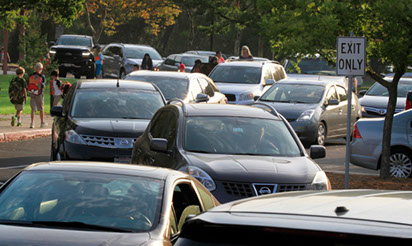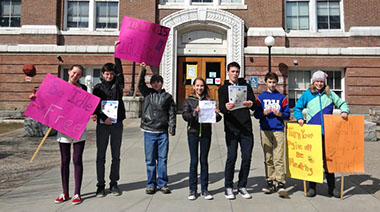Schools
Schools can be seen as taking center stage on the issue of the harm and waste of unnecessary vehicle idling - on both sides of the coin. They represent the challenges in dealing with it and the opportunities of eliminating it. On the one side, the transportation network of school buses and other vehicles that serve the school environment presents the challenge of the need to protect the citizens of the school, particularly its students. Drivers must be made aware that idling on the school premises is a harmful practice. On the other side, schools present a tremendous opportunity to educate future motorists - before they acquire misinformed habits about idling, as well as the opportunity to change the behavior of adults - current motorists in the school community.
Idle-Free California advocates to reduce vehicle idling at schools on two levels: regulations and education.
REGULATIONS: California regulates the idling of vehicles 10,000 lbs. or greater. In the school environment, this includes medium- and heavy-duty school buses and delivery vehicles. Vehicles less than 10,000 lbs, mainly light-duty vehicles such as passenger cars, SUVs, vans and pickup trucks, are not regulated for idling. This allows motorists to let their engines run while waiting for dismissal. In our idle-free schools campaigns we have witnessed the amount of idling occurring at schools. The line up of mostly idling vehicles is known as caravan idling, which creates idling "hot spots" near school entrances. This has an adverse impact on people in the vicinity, especially students. The U.S. EPA states:
"Idling vehicles contribute to air pollution and emit air toxins, which are pollutants known or suspected to cause cancer or other serious health effects. Monitoring at schools has shown elevated levels of benzene, formaldehyde, acetaldehyde and other air toxics during the afternoon hour coinciding with parents picking up their children. Children’s lungs are still developing, and when they are exposed to elevated levels of these pollutants, children have an increased risk of developing asthma, respiratory problems and other adverse health effects. Limiting a vehicle’s idling time can dramatically reduce these pollutants and children’s exposure to them."
California recognized this issue in 2016 when the state legislature took a step on behalf of school student health by adopting ACR-160. Sponsored by former assemblymember David Hadley, this resolution addresses the issue of vehicular air pollution, specifically motor vehicle idling and children. This measure encourages motorists to not idle their motor vehicles near places where children congregate. Unfortunately, ACR-160 is non-binding - it is not enforceable.
legislature took a step on behalf of school student health by adopting ACR-160. Sponsored by former assemblymember David Hadley, this resolution addresses the issue of vehicular air pollution, specifically motor vehicle idling and children. This measure encourages motorists to not idle their motor vehicles near places where children congregate. Unfortunately, ACR-160 is non-binding - it is not enforceable.
Idle-Free California is encouraging legislators and the Air Resources Board to elevate this measure to an enforceable regulation. These entities need to hear from YOU.
WHAT YOU CAN DO:
• Sign the Idle-Free California PETITION at change.org to Regulate vehicle idling at schools in California
• Using the compelling language by the EPA and in ACR-160 above, let your representatives know you would like a
California light-duty vehicle idling regulation to limit idling at schools or where children congregate.
• Likewise contact California Air Resources Board board members, some of which serve on local air districts and/
or are experts in fields that shape air quality rules. SEARCH ONLINE for these board member's contact information
• Contact your county California School Superintendent, school district head, local school principal, and/or
Department of Education School Facilities Staff of the School Facilities and Transportation Services Division in
support raising awareness of vehicle idling on school grounds.
• Inform local school administrators if witnessing prolonged idling of school buses or commercial vehicles on school
grounds; if unresolved, contact the California Dept. of Education
EDUCATION: To educate on the adverse effects of vehicle idling at schools, Idle-Free California recommends—and offers full resources on—two approaches:
1. IDLE-FREE SCHOOLS CAMPAIGNS
Idle-free schools campaigns address the issue of idling “hot spots” at many schools, for instance when parents pick up students in afternoon pick up areas (California regulates the idling of school buses and other heavy-duty vehicles at or near schools; light-duty vehicles are not regulated). The solution: science, math, STEM, health, and environmental teachers and their students conduct idle-free campaigns. These can be six week long short-term efforts in which data of idling vehicles is collected on school grounds, followed by an evaluation and an informational campaign to get the word out in the school community. Or unique long-term studies and campaigns which can last four to five months of the school year. Steps include unobtrusive data collection for one week in the fall, schools announcing support of an idle-free campaign in the school community in late fall, a driver contact event for two days in late winter, and final data collection for one week in spring (to determine a "before" and "after" difference). These campaigns are designed to be led by middle and high school students, allowing them to learn organizational, analytical and communication skills as they perform data analysis, be empowered by showing drivers the significant benefits in shutting off engines when parked, and take pride in making a positive difference in their school community.
“hot spots” at many schools, for instance when parents pick up students in afternoon pick up areas (California regulates the idling of school buses and other heavy-duty vehicles at or near schools; light-duty vehicles are not regulated). The solution: science, math, STEM, health, and environmental teachers and their students conduct idle-free campaigns. These can be six week long short-term efforts in which data of idling vehicles is collected on school grounds, followed by an evaluation and an informational campaign to get the word out in the school community. Or unique long-term studies and campaigns which can last four to five months of the school year. Steps include unobtrusive data collection for one week in the fall, schools announcing support of an idle-free campaign in the school community in late fall, a driver contact event for two days in late winter, and final data collection for one week in spring (to determine a "before" and "after" difference). These campaigns are designed to be led by middle and high school students, allowing them to learn organizational, analytical and communication skills as they perform data analysis, be empowered by showing drivers the significant benefits in shutting off engines when parked, and take pride in making a positive difference in their school community.
2. GREEN DRIVING FROM THE START classroom sessions
These are intended to supplement to high school curricula, taught in science, math, STEM, health, environment, and driver education classes. These sessions can include information on vehicle idling, negative impacts of idling (health, energy, carbon, economic) and even when idling can be necessary.
OTHER RESOURCES: Sustainable Jersey Anti-Idling Education & Enforcement, Clean Cities Idlebox Toolkit for Idling Reduction Projects, EPA Region 8 Idle Free Schools Toolkit, Spare the Air Turn the Key – Be Idle Free!, Grades of Green No Idle Zone
Morello Park Elementary, Martinez, CA - East Bay Times
Idle-Free California proposal to regulate the idling of vehicles less than 10,000 lbs. on school property
Idle-Free Schools Efforts in California
Listing of known idle-free schools campaigns or initiatives in California - TELL US YOURS!:
SACRAMENTO REGION
Sacramento County Idle-Free Schools (Orangevale Open K-8 and K. L. Albiani Middle School), 2018 Webpage
Organized by: Idle-Free California
Language Academy School of Sacramento, 2019 Video
Organized by: Sacramento 350
BAY AREA
Pleasanton Middle School, 2015 Article
Organized by: Spare the Air, San Francisco
San Carlos School District, 2015 Webpage
Organized by: San Mateo County Safe Routes to School: Idle Free San Carlos
Pittsburg Unified School District/Martin Luther King Jr. Junior High School, 2016 Article Video
Organized by: Spare the Air, San Francisco
Alhambra High School, Martinez, 2017 Article
Organized by: Contra Costa County Board of Supervisors, Martinez
Los Altos High School, 2018-2019 Article Article
Organized by: LAHS Green Team and GreenTown
Altamont Creek Elementary School, Livermore, 2019 Article
Organized by: Livermore Valley Joint Unified School District (LVJUSD)
Santa Cruz City Schools (10+ schools), 2019 Article
Organized by: City of Santa Cruz Climate Action Program
Blach Intermediate School, Los Altos, 2019 Article
Organized by: Los Altos School Board and City Council, Nature and Conservation for Kids (NACK), and GreenTown
SAN JOAQUIN VALLEY
Walter Brown Elementary School, Turlock, 2016 Article
Organized by: Central California Asthma Collaborative, HALS program
Venture Academy Family of Schools, Stockton, 2019 Teacher: Christina Fugazi, Delta VISTA Science Teacher
Organized by: San Joaquin County Climate Action Coalition - summary of SJCCAC's work
SOUTHERN CALIFORNIA
Oak Park Unified School District, 2012 No Idling Policy
Robinson Elementary School, Manhattan Beach, 2016 Video
Organized by: Grades of Green, El Segundo
Woodbury Elementary School, Irvine, 2017 Webpage
Organized by: Grades of Green, El Segundo
Grandview Elementary School, Manhattan Beach, 2017 Webpage
Organized by: Grades of Green, El Segundo
Oceanside USD and Vista USD, 2019-2020 Article Audio - Tiny Climate Challenge podcast, Aug. 2019: Idle Free
Organized by: CleanEarth4Kids.org
Cabrillo Middle School, Ventura, 2019-2020 Webpage featured in CleanTechnica
Organized by: eighth-grade student Amelia B., with approval of school principal.
School Buses
Most school buses are equipped with heavy-duty diesel engines. Thanks to EPA regulations and the California Air Resources Board (CARB) Lower Emissions School Bus Program, the vast majority of California's 25,000+ school buses have lower emissions. The primary goal of this program is to reduce school children's exposure to both cancer-causing and smog-forming pollution. The program provides grant funding for new, cleaner, safer school buses and to put air pollution control equipment (i.e., retrofit devices) on buses that are already on the road.
Furthermore, the California School Bus Idling and Idling at Schools Regulation limits idling of school buses and heavy-duty commercial motor vehicles greater than 10,000 pounds that operate at or near schools. This regulation is a big win, that not only protects school students and others from diesel exhaust, it reduces carbon emissions, conserves energy, and saves California taxpayers money in unburned fuel and lessened engine maintenance.
Observation of Idling School Bus, Transit Bus or Delivery Vehicle On or Near School Property: Idling commercial vehicles are detrimental to California's air quality. You can help reduce the harmful air pollutants caused by idling school buses or delivery vehicles by calling the California Air Resources Board's Vehicle Complaint Hotline, at 1-800-363-7664 or 1-800-END-SMOG. Or, fill out the ARB online complaint form. The ARB will be in contact with the vehicle owner to address the issue.
ELECTRIC SCHOOL BUSES. THE WAVE OF THE FUTURE (and the present): While still relatively in their infancy, as production grows to lower costs, and battery capabilities improve, clean electric school buses are making inroads. And California is leading the way with new or retrofitted electric school buses being added to fleets of school districts. Below are USDs with electric school buses as of summer 2018 (with many more as of 2020!):
•Anaheim Elementary School District
•Brawley Elementary School District
•Calaveras Unified School District
•Chico Unified School District
•Coachella Valley Unified School
•Covina-Valley Unified School District
•Edison School District
•Fall River Joint Unified School District (Burney)
•Gateway Unified School District
•Gilroy Unified School District
•Gonzales Unified School District
•Healdsburg Unified School District
•Kings Canyon Unified School District (Reedley)
•Konocti Unified School District
•Los Angeles Unified School District
•Magnolia School District
•Montebello Unified School District
•Napa Valley Unified School District
•Oroville Union High School District
•Palermo Union School District
•Plumas Unified School District
•Rescue Union School District
•Santa Rita Union Elementary School District
•Savanna School District
•Torrance Unified School District
•Twin Rivers Unified School District (McClellan Park)
•Ukiah Unified School District
•Wilsona School District (Palmdale)
The ChildSafe School: No Idling Zone
KCRA NBC3: MCCLELLAN PARK, Calif. - December 18, 2019
California is changing the way that kids go to school -- replacing dirty diesel buses that pollute the air with something cleaner and greener.
“The electric school bus will be the school bus of the future,” said David Hochschild, chair of the California Energy Commission.
That future is electric at the Twin Rivers Unified School District in Sacramento, which just received five new electric buses this week. The district has a total of 29 zero-emission school buses, or roughly 1 out of every 4 buses in operation.
